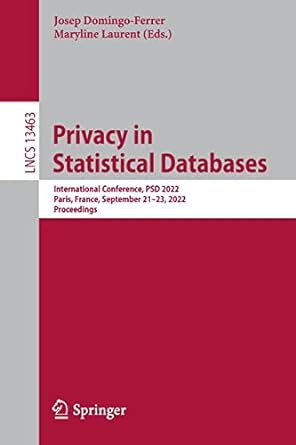Question
Add the following methods to the JAVA class: A. isPerfectMirror(); returns true if this list is a mirror. Use the Chapter 15 exercise #18 definition
Add the following methods to the JAVA class:
A. isPerfectMirror(); returns true if this list is a mirror. Use the Chapter 15 exercise #18 definition of mirror(). For example, if this LinkedList contains the values ["a", "b", "c", "c", "b", "a"] then isPerfectMirror() returns true, while ["a", "b", "c"] would return false.
B . undoMirror() will undo a mirror structure. It should first check if this is mirrored, before attempting to undo the mirror. If this list is not mirrored, then undoMirror() does nothing. Its avoid method that will undo the mirror if this list is mirrored, as in isPerfectMirror() returns true. Whenever isPerfectMirror() is false, the undoMirror() method leaves this list unchanged..
CLASS:
import java.util.*;
public class LinkedList
private ListNode
private ListNode
private int size; // current number of elements
public LinkedList() {
front = new ListNode
back = new ListNode
clear();
}
// post: returns the current number of elements in the list
public int size() {
return size;
}
// pre : 0 <= index < size() (throws IndexOutOfBoundsException if not)
// post: returns the value at the given index in the list
public E get(int index) {
checkIndex(index);
ListNode
return current.data;
}
// post: creates a comma-separated, bracketed version of the list
public String toString() {
if (size == 0) {
return "[]";
} else {
String result = "[" + front.next.data;
ListNode
while (current != back) {
result += ", " + current.data;
current = current.next;
}
result += "]";
return result;
}
}
// post: creates a comma-separated, bracketed version of the list
// Iverson creation
public String backwards() {
if (size == 0) {
return "[]";
} else {
String result = "[" + back.prev.data;
ListNode
while (current != front) {
result += ", " + current.data;
current = current.prev;
}
result += "]";
return result;
}
}
// post : returns the position of the first occurrence of the given
// value (-1 if not found)
public int indexOf(E value) {
int index = 0;
ListNode
while (current != back) {
if (current.data.equals(value)) {
return index;
}
index++;
current = current.next;
}
return -1;
}
// post: returns true if list is empty, false otherwise
public boolean isEmpty() {
return size == 0;
}
// post: returns true if the given value is contained in the list,
// false otherwise
public boolean contains(E value) {
return indexOf(value) >= 0;
}
// post: appends the given value to the end of the list
public void add(E value) {
add(size, value);
}
// pre: 0 <= index <= size() (throws IndexOutOfBoundsException if not)
// post: inserts the given value at the given index, shifting subsequent values right
public void add(int index, E value) {
if (index < 0 || index > size) {
throw new IndexOutOfBoundsException("index: " + index);
}
ListNode
ListNode
current.next = newNode;
newNode.next.prev = newNode;
size++;
}
// post: appends all values in the given list to the end of this list
public void addAll(List
for (E value: other) {
add(value);
}
}
// pre : 0 <= index < size() (throws IndexOutOfBoundsException if not)
// post: removes value at the given index, shifting subsequent values left
public void remove(int index) {
checkIndex(index);
ListNode
current.next = current.next.next;
current.next.prev = current;
size--;
}
// pre : 0 <= index < size() (throws IndexOutOfBoundsException if not)
// post: replaces the value at the given index with the given value
public void set(int index, E value) {
checkIndex(index);
ListNode
current.data = value;
}
// post: list is empty
public void clear() {
front.next = back;
back.prev = front;
size = 0;
}
public Iterator
return new LinkedIterator();
}
private ListNode
ListNode
if (index < size / 2) {
current = front;
for (int i = 0; i < index + 1; i++) {
current = current.next;
}
} else {
current = back;
for (int i = size; i >= index + 1; i--) {
current = current.prev;
}
}
return current;
}
private void checkIndex(int index) {
if (index < 0 || index >= size()) {
throw new IndexOutOfBoundsException("index: " + index);
}
}
private static class ListNode
public E data; // data stored in this node
public ListNode
public ListNode
public ListNode(E data) {
this(data, null, null);
}
public ListNode(E data, ListNode
this.data = data;
this.next = next;
this.prev = prev;
}
}
private class LinkedIterator implements Iterator
private ListNode
private boolean removeOK; // whether it's okay to remove now
// post: constructs an iterator for the given list
public LinkedIterator() {
current = front.next;
removeOK = false;
}
// post: returns true if there are more elements left, false otherwise
public boolean hasNext() {
return current != back;
}
// pre : hasNext()
// post: returns the next element in the iteration
public E next() {
if (!hasNext()) {
throw new NoSuchElementException();
}
E result = current.data;
current = current.next;
removeOK = true;
return result;
}
// pre : next() has been called without a call on remove (i.e., at most
// one call per call on next)
// post: removes the last element returned by the iterator
public void remove() {
if (!removeOK) {
throw new IllegalStateException();
}
ListNode
prev2.next = current;
current.prev = prev2;
size--;
removeOK = false;
}
}
}
Step by Step Solution
There are 3 Steps involved in it
Step: 1

Get Instant Access to Expert-Tailored Solutions
See step-by-step solutions with expert insights and AI powered tools for academic success
Step: 2

Step: 3

Ace Your Homework with AI
Get the answers you need in no time with our AI-driven, step-by-step assistance
Get Started


